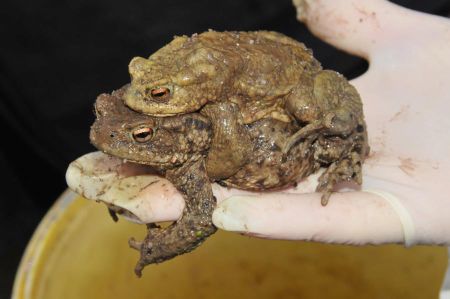Toad fences between Geiselwind and Aschbach
- Written by Portal Editor
After an interesting meeting with a major tour operator in Geiselwind and a tour of a mobile home from a local manufacturer, we were on our way back to our office in Kitzingen when we saw a few meters of the low toad fence on Landstraße 2260 right next to the road.
About halfway down the fence, a county worker was busy checking the fence. We had already discussed the topic of toad migration in the Kitzingen area beforehand, so only a brief thought was necessary before we stopped and asked the employee about his work. A little later we were deep in conversation and found out that the young man was doing his civil service as a Bufdi at the district office in Kitzingen in the area of environment, nature and landscape conservation and was now supposed to check the barrier fences shortly before the start of the annual toad migration.
Frogs and toads with the migration

Nature lovers almost everywhere in Germany have made a virtue of their experiences and developed a protection system for toads, frogs and amphibians that is set up and maintained at this time of year: the toad fence.
For a better understanding and also to guide the voluntary helpers, instructions have even been created that have been written as a leaflet. This leaflet explains the importance of the details that must always be restored during the patrols.
Important tool to protect the stocks of endangered toads, frogs and newts

“The effectiveness of the fences is easily verifiable; we keep lists of all animals found along our protective fences.
"The amphibian protection fences are therefore an important instrument for protecting the stocks of endangered toads, frogs and newts. The supervisors enter data such as temperature and weather, bucket number and number of animals per bucket in a data sheet. The statistics are forwarded from the Lower Nature Conservation Authority to the Upper Nature Conservation Authority in the government of Lower Franconia."
Beginning of the toad migration
After this interesting information, we asked for further details and streets, which were also provided with protective fences. The fence inspector promised to establish contact with other active people who work on behalf of the district office. We said goodbye to each other after exchanging our contact details.
The next day, the person responsible for the Marktbreit - Michelfeld section promptly called and - thanks to the slightly increased temperatures, which are only now causing the toad migration to begin, we made an appointment for the coming Thursday on the route mentioned. We are excited to see what awaits us there.
Amphibian protection fence – construction and maintenance
- Thread in the fence, tighten (always 2 men) and clamp.
- Then press or hammer in the post completely.
- If necessary, seal the fence towards the ground so that the amphibians cannot slip under the fence.
- Tension the fence every 50m if necessary.
- Please do not cut fences. Leave the rest rolled up at the end of the fence.
- On the immigration side, bury catch vessels (buckets) flush with the ground (at the fence) at a distance of approx. 20 m.
- It is important that there is a forced pass between the fence foil and the bucket so that the amphibians have to fall into the bucket.
- Through exit aids, e.g. For reasons of animal welfare, shrews, ground beetles and other small animals must be able to get out of the catcher buckets, e.g. wooden sticks and branches with a diameter of at least 4 cm.
- The caught amphibians are freed from the buckets every morning during the main migration period and also at night in the case of strong populations and returned in the direction of migration, approx. 50m from the road, in protected areas, i.e. in ditches, on hedges or directly on the water exposed.
Please also read:
Franconian Switzerland - fly fishing on the Wiesent
Stand-up paddling at Lake Ohrid - a meeting with Linda and Jochen
